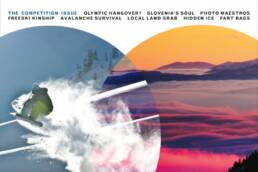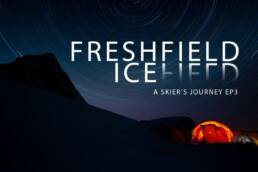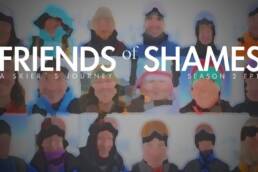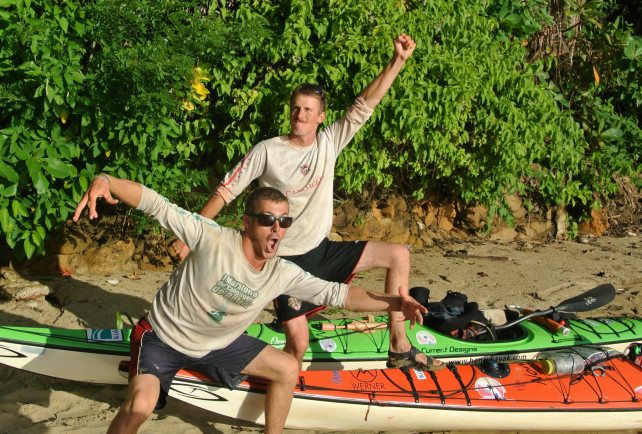
Thanks to Canoe and Kayak, and Conor Mihell for the interview. – ed
Victoria, B.C.-based brothers Russell and Graham Henry caught our attention last spring when they announced an ambitious plan to sea kayak from Belém, Brazil, to Key West, Fla. The 4,000-mile journey would include two distinctly different legs: along the muddy and forbidding tidal flats of the South American coast; and island-hopping across the Caribbean Sea—including four major crossings up to 80 miles in length. John Dowd, a Kiwi ex-pat and legendary sea kayaker who completed a similar trans-Caribbean expedition in the late 1970s, was skeptical of the Henrys’ plans. “I would question the decision to take single kayaks,” said Dowd in an interview for the August issue of Canoe & Kayak magazine.
But so far, Russell, 21, and Graham, 22, have proven their critics wrong. They wrapped up the South American leg in early October with little adversity, and recently completed the challenging 80-mile crossing from Tobago to Grenada. We caught up with them after they completed the 30-hour passage.
CanoeKayak.com: What did it feel like to take the first paddle strokes on this journey when you set off from Belém a couple of months ago?
Russell Henry: Leaving Belém was definitely a strange feeling. We had developed some crazy, odd and incredible friendships there and it was almost tough leaving. As we paddled the first three miles with a crew of 20 other paddlers and two film crews on motor boats we felt like total rock stars. It was pretty cool. After we said so long to everyone it was really back to basics with just Graham and me on a kayak trip together.
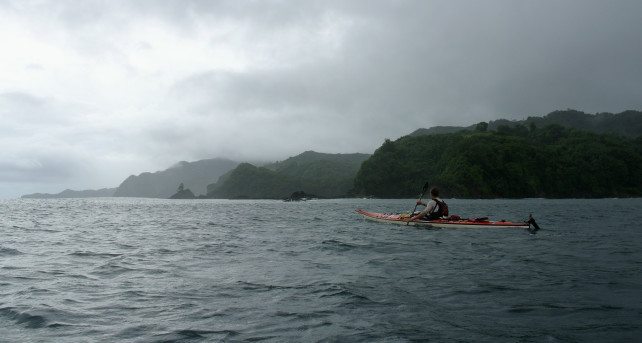
The South American coast is said to be low and muddy without many attractive landing options. Was that your experience (and what was the camping like)?
RH: Yeah, the South American coastline really sucked. Lots of bugs and loads of mud. Our last two weeks in Brazil were exceptionally tough. Lots of beaches, but unfortunately due to the weird currents from the Amazon we had a limited time frame in which being on the water was worth it. This meant that we always had either a huge boat haul at the end of the day, or a huge boat haul at the start of the day. There were sometimes 20-foot tides so I’m talking a mile or so from the start of the beach to a spot where the water wouldn’t reach in the middle of the night.
Then there were the couple times where there were no beaches, only mud. Death mud. When I say death mud I mean it’s mud that if you were to step in you would keep on sinking and not stop. So on those couple nights we parked ourselves in our kayaks on the mud, let the tide go out, slept semi-prone in our boats for six hours, woke up when we were floating again, and then went kayaking again.
Any pirates?
RH: No sir, no pirates, and no negative experiences except for the bugs and the mud. When we started this trip we thought the biggest danger was going to be the people. Not necessarily because of how ‘dangerous’ the countries are, but because of how much of a wild card people are. They are the one major thing we couldn’t really fully prepare for. Well, everyone has been just so darn nice. It’s crazy! The generosity of everyone we’ve met so far has been unbelievable. All this hubbub about pirates and bad folks here and there was good in that it got us on our toes and ready for if something were to happen, but in reality we haven’t met a single bad guy yet. The closest thing we came to with pirate encounters was when Graham had a stress fest as a boat of “scary looking drug lords” approached us on the Venezuelan border. Turned out it was a fisherman and his eight kids coming to say hey.
Did you take a bit of a rest in Trinidad and Tobago?
Graham Henry: We took a great rest in Tobago as we are viewing that spot as the mental halfway point of the trip. We have South America in the bag and are looking north to the Caribbean now. It was also super nice to meet our parents in Tobago and spend some good quality time with the family on an island paradise. We spent four days of rest exploring the island, fixing gear and just generally taking it easy. It was great.
What did it feel like setting off on the big crossing to Granada?
GH: Setting off on the big crossing was a bit of a weird mental experience. I don’t know if it is because we have been dealing with risk and big challenges for the last few months or if we were just really comfortable with the risk we were taking, but there wasn’t a whole lot of emotion tied to the takeoff. It was sort of just the “well this is going to be pretty lousy” feeling. We are getting good at this feeling. I don’t think this adventure is making us particularly brave but I do think it is helping us deal with fear and panic when these emotions would only be a danger to us. A danger likely greater than paddling 80 miles across rough open ocean.
Did you look for a weather window? What was the crossing like?
GH: We tried hard to hit the best weather window possible for the crossing and pushed off on Tuesday, October 22 around 9:30 a.m. The weather window we hit was with easterly winds around 15 knots and a chance of showers. We would have loved some lighter winds somewhere in there so we could relax in our boats but every day in the forecast on either side was actually windier. The beginning of the crossing went super smoothly and we paddled hard into the wind for several hours. Once we got far enough away from Tobago the localized winds eased up and we hit those easterlies pushing us in almost exactly the right direction. By the time dinner (pre-cooked cold pizza) rolled around we had just about lost sight of Tobago behind us and were pushing into that uncomfortable place where you can’t see land in any direction.
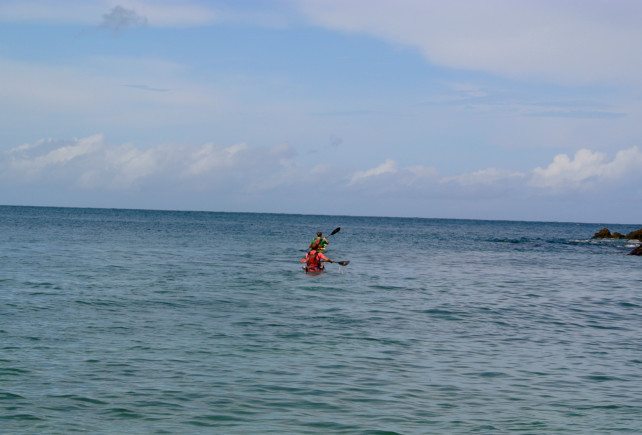
Paddling at night is actually starting to really grow on us. Using stars to keep in a straight line helps a lot with sea sickness and not being able to see anything makes the mental game that much easier. The wee hours of the morning were tough simply due to trying to stay awake. We have attachable floats for the boats that would allow one of us to sleep but there was no break in the choppy and burly water for us to attach or use them effectively. So, that meant no sleep and by the time the sun finally rose and we got our first glimpse of Grenada, Russell was falling asleep in his boat. He nodded off a couple times and after that we forced talking between us and chatting about total nonsense just to stay conscious. During breakfast we had our first case of really lousy seasickness and Russ upchucked everywhere. Once it was out though he felt better and we had a very long 12-mile slog to shore. Arriving on shore was total bliss as our parents had flown around to this side of the crossing to meet us and that meant we had a place to stay other than our tent. We headed up from the beach and after a brief debrief had a glorious nap for over six hours. Overall it was a super long mental game that really pushed us hard. Our bodies were up for the challenge after paddling 1,800 miles from Belem but now it is time to get our heads around some really long stints on really big water. Yee-haw!
What are you most looking forward to in the Caribbean leg of your journey?
GH: Up until now the paddling has been generally super easy with a tailwind and current. The flat/muddy bottom also tends to flatten out the swell and leave only small choppy wind waves. The camping however has been a huge challenge and even just finding dry ground at night has proved difficult. This all flips 180 degrees now that we are in the Caribbean. The paddling gets much bigger with higher winds, larger swell, and more committed crossings. Meanwhile, the camping turns from nightmare to paradise with beautiful beaches around just about every corner. Needless to say, we are looking forward to this change of pace.
Anything else you think we should know?
RH: Yeah, we’re super excited about the outreach we’ve made with youth so far. From the get go we’d been planning to present our trip story at schools upon return to Canada with hope to inspire kids to get outside and promote the power of education through adventure. We deemed it unreasonable and not possible to reach kids throughout the trip in the countries we travel through. However, thanks to some contacts we’ve made with teachers and other school faculty we’ve presented at schools in Suriname, Trinidad, and already have two talks lined up in the Grenadines. The reception from the students was awesome. They were so captivated by us and everything we had to say it was really gratifying. We are still receiving emails from students with their thanks and desire to get out there themselves. Not only has this motivated us for our trip, but it has built our stokedness to talk with more schools along the trip and once we return home.
Related Stories
Japan: A Skiers Journey EP1 S3
Follow skiers Chad Sayers and Forrest Coots through Japan as they explore a world of contrasts. From Tokyo’s city…
A Skier’s Journey – Iceland
"In Iceland's rough and remote Westfjords region, Chad Sayers, Forrest Coots, and Chad Manley step back in time to…
Argentina: A Skier’s Journey EP3 [Season 2]
Produced by CMC contributor Jordan Manley. A Skier's Journey EP3 [Season 2] is a road trip through some of Argentina's…
Freshfield Icefield: A Skier’s Journey, by Jordan Manley
The last in a series of three ski-travel episodes (Ep1: Kashmir - A Skier's Journey / Ep2: La Grave - A Skier's…
Baffin Island Couloirs: A Skier’s Journey EP2 [Season 2]
Baffin Island: A Skier's Journey EP2 [Season 2] from Jordan Manley Photography on Vimeo. Produced by CMC contributor…


